Impact of Cryogenic Treatment Process on the Performance of 51CrV4 Steel
Abstract
:1. Introduction
2. Experimental Procedure
2.1. Material Selection and Temperature Settings
2.2. Testing of Hardness and Wear Volume
2.3. Testing of Impact Toughness of 51CrV4 Spring Steel
2.4. Tensile Testing of 51CrV4 Spring Steel
3. Results and Discussion
3.1. Experimental Data
3.1.1. Experimental Data Preprocessing
3.1.2. Gray Correlation Analysis
3.1.3. Analysis of Variance
3.2. Testing and Analysis of Wear Resistance
3.3. Analysis of Tensile Test Results
3.4. Analysis of Microstructure
3.5. Analysis of Impact Fracture
3.5.1. Macroscopic Analysis of Impact Fracture
3.5.2. Microscopic Analysis of Impact Fracture
4. Conclusions
- (1)
- Considering the overall performance of 51CrV4 spring steel in terms of Rockwell hardness, impact toughness, and wear resistance, the holding time has the most significant influence on the comprehensive performance, with a contribution rate of 49.01%. The optimized process obtained through gray correlation analysis is as follows: a holding time of 24 h, a cooling rate of 1 °C/min, two cycles, and a cryogenic temperature of −196 °C.
- (2)
- Following cryogenic treatment, specimens from group 3 of 51CrV4 spring steel, characterized by a 24-h holding time, cooling rate of 1 °C/min, three cycles, and cryogenic temperature of −196 °C, exhibit notable improvements in various mechanical properties. Specifically, a substantial reduction of approximately 43.32% in wear is observed, while the Rockwell hardness shows a slight improvement compared to the control group, maintaining its level of hardness. Furthermore, a notable enhancement of 4.01% in impact toughness relative to the control group is achieved, along with an increase in overall strength.
- (3)
- Following cryogenic treatment, the microstructure of 51CrV4 spring steel exhibits distinct features, including well-defined elongated needle-shaped bainite and plate-like martensite. Additionally, small carbide particles precipitate, while coarse martensite fragments and noticeable variations in orientation occur. These microstructural alterations are macroscopically manifested through enhancements in impact toughness, hardness, and the wear resistance properties of the material.
- (4)
- With an increasing number of cryogenic treatments, the diameter and depth of equiaxed tough areas on the fracture surface of 51CrV4 spring steel exhibit a notable growth. Simultaneously, the size of inclusions within these tough areas diminishes, indicating reduced specimen defects and enhanced impact toughness. Furthermore, the impact of elements present in the inclusions on toughness was explored through EDS analysis. The findings reveal a positive influence of Ca on impact toughness, while S exhibits a negative effect.
Author Contributions
Funding
Institutional Review Board Statement
Informed Consent Statement
Data Availability Statement
Conflicts of Interest
References
- Wang, Y.; Fu, L.; Zhou, M.; Zhou, Z.; Pang, X.; Zhong, S.; Volinsky, A.A. Thermodynamics Analysis of Multiple Micro-elements’ Coupling Behavior in High Fatigue Resistance 50CrVA Spring Steel with Nanoparticles. Materials 2019, 12, 2952. [Google Scholar] [CrossRef] [Green Version]
- Gonçalves, V.R.M.; Podgornik, B.; Leskovšek, V.; Totten, G.E.; Canale, L.d.C.F. Influence of Deep Cryogenic Treat-ment on the Mechanical Properties of Spring Steels. J. Mater. Eng. Perform. 2019, 28, 769–775. [Google Scholar] [CrossRef]
- James, M.N.; Hattingh, D.G.; Matthews, L. Embrittlement failure of 51CrV4 leaf springs. Eng. Fail. Anal. 2022, 139, 106517. [Google Scholar] [CrossRef]
- Li, J.; Min, Y.; Wang, P.; Cai, X.; Wu, X. Analysis of Distortion Mechanism of a Cold Work Tool Steel During Quenching and Deep Cryogenic Treatment. Met. Mater. Int. 2018, 25, 546–558. [Google Scholar] [CrossRef]
- Hu, F.; Wu, K.; Hodgson, P.D.; Shirzadi, A.A. Refinement of Retained Austenite in Super-bainitic Steel by a Deep Cryogenic Treatment. ISIJ Int. 2014, 54, 222–226. [Google Scholar] [CrossRef] [Green Version]
- Li, D.-H.; He, W.-C.; Zhang, X.; Xiao, M.-G.; Li, S.-H.; Zhao, K.-Y.; Yang, M.-S. Effects of traditional heat treatment and a novel deep cryogenic treatment on microstructure and mechanical properties of low-carbon high-alloy martensitic bearing steel. J. Iron Steel Res. Int. 2021, 28, 370–382. [Google Scholar] [CrossRef]
- Zheng, M.; Kong, J.; Sun, Y.; Kumar, K. Optimization of Cryogenic Process Parameters for the Minimization of Surface Residual Stress in Pure Iron Using Taguchi Design. Math. Probl. Eng. 2021, 2021, 1–12. [Google Scholar] [CrossRef]
- Guo, P.; Deng, L.; Wang, X.; Jin, J. Simultaneous Improvement of Toughness and Fatigue Life in a Typical Ultrahigh Strength Steel by a New Deep Cryogenic Treatment Process. ISIJ Int. 2021, 61, 463–472. [Google Scholar] [CrossRef]
- Vijayakumar, M.; Shanawaz, A.M.; Prabhu, N.; Arunprasath, K.; Ramesh, C.; Mohan, M. The influence of cryogenic treatment on titanium alloys mechanical properties. Mater. Today Proc. 2022, 66, 883–888. [Google Scholar] [CrossRef]
- Barylski, A.; Aniolek, K.; Dercz, G.; Kupka, M.; Matula, I.; Kaptacz, S. The Sclerometrical, Mechanical, and Wear Be-havior of Mg-Y-Nd Magnesium Alloy after Deep Cryogenic Treatment Combined with Heat Treatment. Materials 2021, 14, 1218. [Google Scholar] [CrossRef]
- Baldissera, P.; Delprete, C. Effects of deep cryogenic treatment on static mechanical properties of 18NiCrMo5 carburized steel. Mater. Des. 2009, 30, 1435–1440. [Google Scholar] [CrossRef]
- Gassama, B.; Ozden, G.; Oteyaka, M.O. The effect of deep cryogenic treatment on the wear properties of AZ91 magnesium alloy in dry and in 0.9 wt% NaCl medium. Sādhanā 2022, 47, 15. [Google Scholar] [CrossRef]
- Chinnasamy, M.; Rathanasamy, R.; Pal, S.K.; Palaniappan, S.K. Effectiveness of cryogenic treatment on cutting tool inserts: A review. Int. J. Refract. Met. Hard Mater. 2022, 108, 105946. [Google Scholar] [CrossRef]
- Cui, C.; Gu, K.; Qiu, Y.; Weng, Z.; Zhang, M.; Wang, J. The effects of post-weld aging and cryogenic treatment on self-fusion welded austenitic stainless steel. J. Mater. Res. Technol. 2022, 21, 648–661. [Google Scholar] [CrossRef]
- Lee, S.; Im, Y.-D.; Matsumoto, R.; Utsunomiya, H. Strength and electrical conductivity of Cu-Al alloy sheets by cryogen-ic high-speed rolling. Mater. Sci. Eng. A 2021, 799, 139815. [Google Scholar] [CrossRef]
- Kara, F.; Küçük, Y.; Özbek, O.; Özbek, N.A.; Gök, M.S.; Altaş, E.; Uygur, İ. Effect of cryogenic treatment on wear be-havior of Sleipner cold work tool steel. Tribol. Int. 2023, 180, 108301. [Google Scholar] [CrossRef]
- Özden, R.C.; Anik, M. Enhancement of the mechanical properties of EN52CrMoV4 spring steel by deep cryogenic treatment. Mater. Werkst. 2020, 51, 422–431. [Google Scholar] [CrossRef]
- Arun, M.; Arunkumar, N.; Vijayaraj, R.; Ramesh, B. Investigation on the performance of deep and shallow cryogenic treated tungsten carbide drills in austenitic stainless steel. Measurement 2018, 125, 687–693. [Google Scholar] [CrossRef]
- Zhang, H.; Yan, X.; Chen, Z.; Zhao, M.; Tang, L.; Gao, Y.; Li, F.; Huang, Y.; Li, J. Effect of cryogenic treat-ment on wear resistance and microstructure of 42CrMo Steel. Arch. Metall. Mater. 2022, 67, 127–135. [Google Scholar]
- Zhang, H.; Yan, X.; Hou, Q.; Chen, Z.; Berthod, P. Effect of Cyclic Cryogenic Treatment on Wear Resistance, Impact Toughness, and Microstructure of 42CrMo Steel and Its Optimization. Adv. Mater. Sci. Eng. 2021, 2021, 1–13. [Google Scholar] [CrossRef]
- Xu, G.; Huang, P.; Feng, Z.; Wei, Z.; Zu, G. Effect of Deep Cryogenic Time on Martensite Multi-Level Microstructures and Mechanical Properties in AISI M35 High-Speed Steel. Materials 2022, 15, 6618. [Google Scholar] [CrossRef] [PubMed]
- Bhaskar, L.; Raj, D.S. Evaluation of the effect of cryogenic treatment of HSS drills at different holding time in drilling AISI 316-SS. Eng. Res. Express 2020, 2, 025005. [Google Scholar] [CrossRef]
- Mazor, G. Influence of cryogenic cooling rate on mechanical properties of tool steels. In Proceedings of the IOP Conference Series: Materials Science and Engineering, Fujian, China, 20–22 October 2017; p. 244. [Google Scholar]
- Zhang, H.; Zhang, G.; Zhou, H.; Liu, Z.; Xu, B.; Hao, L.; Sun, M.; Li, D. Influence of cooling rate during cryogenic treatment on the hierarchical microstructure and mechanical properties of M54 secondary hardening steel. Mater. Sci. Eng. A 2022, 851, 143659. [Google Scholar] [CrossRef]
- Cardoso, P.H.S.; Israel, C.L.; da Silva, M.B.; Klein, G.A.; Soccol, L. Effects of deep cryogenic treatment on microstructure, impact toughness and wear resistance of an AISI D6 tool steel. Wear 2020, 456–457, 203382. [Google Scholar] [CrossRef]
- Dhokey, N.B.; Dandawate, J.; Gangurde, H.; Harle, A. Metallurgical investigation of cryogenically cracked M35 tool steel. Eng. Fail. Anal. 2012, 21, 52–58. [Google Scholar] [CrossRef]
- Chen, Y.; Li, Y.; Zhou, X.; Tan, F.; Jiang, Y. Effects of cryogenic treatment on mechanical properties and crystal orientation of 0.25C-0.80Si-1.6Mn steel with extraordinary strength-toughness. Mater. Res. Express 2021, 8, 036517. [Google Scholar] [CrossRef]
- Jovičević-Klug, P.; Guštin, A.Z.; Jovičević-Klug, M.; Šetina Batič, B.; Lebar, A.; Podgornik, B. Coupled role of alloying and manufacturing on deep cryogenic treatment performance on high-alloyed ferrous alloys. J. Mater. Res. Technol. 2022, 18, 3184–3197. [Google Scholar] [CrossRef]
- Muthuramalingam, T.; Mohan, B. Application of Taguchi-grey multi responses optimization on process parameters in electro erosion. Measurement 2014, 58, 495–502. [Google Scholar] [CrossRef]
- Begic-Hajdarevic, D.; Ficko, M.; Cekic, A.; Simon, K.; Cohodar, M. Multi-response Optimization of Laser Cutting Pa-rameters Using Grey Relational Analysis. In Proceedings of the 30th International DAAAM Symposium, Zadar, Croatia, 23–26 October 2019; pp. 176–183. [Google Scholar]
- Unnikrishna Pillai, J.; Sanghrajka, I.; Shunmugavel, M.; Muthuramalingam, T.; Goldberg, M.; Littlefair, G. Optimisation of multiple response characteristics on end milling of aluminium alloy using Taguchi-Grey relational approach. Measurement 2018, 124, 291–298. [Google Scholar] [CrossRef]
- Darwin, J.D.; Mohan Lal, D.; Nagarajan, G. Optimization of cryogenic treatment to maximize the wear resistance of 18% Cr martensitic stainless steel by Taguchi method. J. Mater. Process. Technol. 2008, 195, 241–247. [Google Scholar] [CrossRef]
- Gul, M.; Shah, A.N.; Jamal, Y.; Masood, I. Multi-variable optimization of diesel engine fuelled with biodiesel using grey-Taguchi method. J. Braz. Soc. Mech. Sci. Eng. 2015, 38, 621–632. [Google Scholar] [CrossRef]
- Das, D.; Dutta, A.K.; Ray, K.K. Sub-zero treatments of AISI D2 steel: Part II. Wear behavior. Mater. Sci. Eng. A 2010, 527, 2194–2206. [Google Scholar] [CrossRef]
- Zheng, D.; Zhao, X.; An, K.; Chen, L.; Zhao, Y.; Khan, D.F.; Qu, X.; Yin, H. Effects of Fe and graphite on friction and wear properties of brake friction materials for high-speed and heavy-duty vehicles. Tribol. Int. 2023, 178, 108061. [Google Scholar] [CrossRef]
- Altan Özbek, N. Effects of Shallow and Deep Cryogenic Treatment on Tool Flank Wear and Surface Roughness in Machining 41Cr4 Steel. J. Mater. Eng. Perform. 2023, 1024–1544. [Google Scholar] [CrossRef]
- Das, D.; Dutta, A.K.; Ray, K.K. Sub-zero treatments of AISI D2 steel: Part I. Microstructure and hardness. Mater. Sci. Eng. A 2010, 527, 2182–2193. [Google Scholar] [CrossRef]
- Jovičević-Klug, P.; Puš, G.; Jovičević-Klug, M.; Žužek, B.; Podgornik, B. Influence of heat treatment parameters on effectiveness of deep cryogenic treatment on properties of high-speed steels. Mater. Sci. Eng. A 2022, 829, 142157. [Google Scholar] [CrossRef]
- Li, X.; Zhang, Z.; Du, B.; Peng, X. Microstructure and Toughness Study of P92 Steel after Tempering. Hot Work. Technol. 2012, 41, 190–192. [Google Scholar] [CrossRef]
- Senthilkumar, D.; Rajendran, I. Effect of cryogenic treatment on the hardness and tensile behaviour of AISI 4140 steel. Int. J. Microstruct. Mater. Prop. 2011, 6, 366–377. [Google Scholar] [CrossRef]
- Senthilkumar, D.; Rajendran, I.; Pellizzari, M.; Siiriainen, J. Influence of shallow and deep cryogenic treatment on the residual state of stress of 4140 steel. J. Mater. Process. Technol. 2011, 211, 396–401. [Google Scholar] [CrossRef]
- Han, L.; Wang, Y.; Liu, S.; Zhang, Z.; Song, X.; Li, Y.; Liu, W.; Yang, Z.; Mu, M. Effect of cryogenic treatment on the mi-crostructure and mechanical properties of selected laser melted H13 steel. J. Mater. Res. Technol. 2022, 21, 5056–5065. [Google Scholar] [CrossRef]
- Reddy Gunamgari, B.; Kumar, G.N.; Kharub, M. Cryogenic processing of AISI P20 tool steel: Evaluation of mechanical properties and microstructure. Mater. Today Proc. 2023, 2214–7853. [Google Scholar] [CrossRef]
- Wang, Y.; Zhang, Y.; Song, R.; Huang, L.; Pei, Y. Effect of the Austenitizing Temperature on Microstructure Evolution and Impact Toughness of a Novel Bainite Ductile Iron. Met. Mater. Int. 2020, 27, 4014–4022. [Google Scholar] [CrossRef]
- Fan, S.; Hao, H.; Zhang, X. Effect of Deep Cryogenic Treatment on the Microstructure and Wear Resistance of a Novel Nanobainite Steel. Steel Res. Int. 2021, 92, 2000554. [Google Scholar] [CrossRef]
- Weng, Z.; Gu, K.; Wang, K.; Liu, X.; Wang, J. The reinforcement role of deep cryogenic treatment on the strength and toughness of alloy structural steel. Mater. Sci. Eng. A 2020, 772, 138698. [Google Scholar] [CrossRef]
- Chen, J.; Liu, Z.-Y.; Wang, G.-D. Exploring the improvement of strength and cryogenic impact toughness in hot-rolled high Mn austenitic steel for cryogenic application. J. Mater. Res. Technol. 2022, 21, 3732–3745. [Google Scholar] [CrossRef]
- Odnobokova, M.V.; Belyakov, A.; Enikeev, N.A.; Kaibyshev, R.O.; Valiev, R.Z. Cryogenic impact toughness of a work hardened austenitic stainless steel. Materialia 2022, 23, 101460. [Google Scholar] [CrossRef]
- Zhu, L.; He, H.; Shan, Y.; Yang, K. Study on Tempering Characteristics of 51CrV4 Spring Steel. Hot Work. Technol. 2010, 39, 144–148. [Google Scholar] [CrossRef]
- Liu, X.; Wang, L.M. Effects of Rare Earth Addition on the Inclusions and Mechanical Properties of 2205 Duplex Stain-less Steel. Adv. Mater. Res. 2012, 503–504, 463–468. [Google Scholar]
- Peng, J.; Zhou, B.; Li, Z.; Huo, D.; Xiong, J.; Zhang, S. Effect of tempering process on the cryogenic impact toughness of 13Cr4NiMo martensitic stainless steel. J. Mater. Res. Technol. 2023, 23, 5618–5630. [Google Scholar] [CrossRef]
- Liu, C.J.; Liu, H.L.; Li, C.L.; Jiang, M.F. Effects of Rare Earth on the Impact Toughness of High-Carbon Steel. Adv. Mater. Res. 2011, 284–286, 1223–1227. [Google Scholar] [CrossRef]
- Zhang, Y.; Yang, J.; Liu, D.; Pan, X.; Xu, L. Improvement of Impact Toughness of the Welding Heat-Affected Zone in High-Strength Low-Alloy Steels through Ca Deoxidation. Metall. Mater. Trans. A 2021, 52, 668–679. [Google Scholar] [CrossRef]
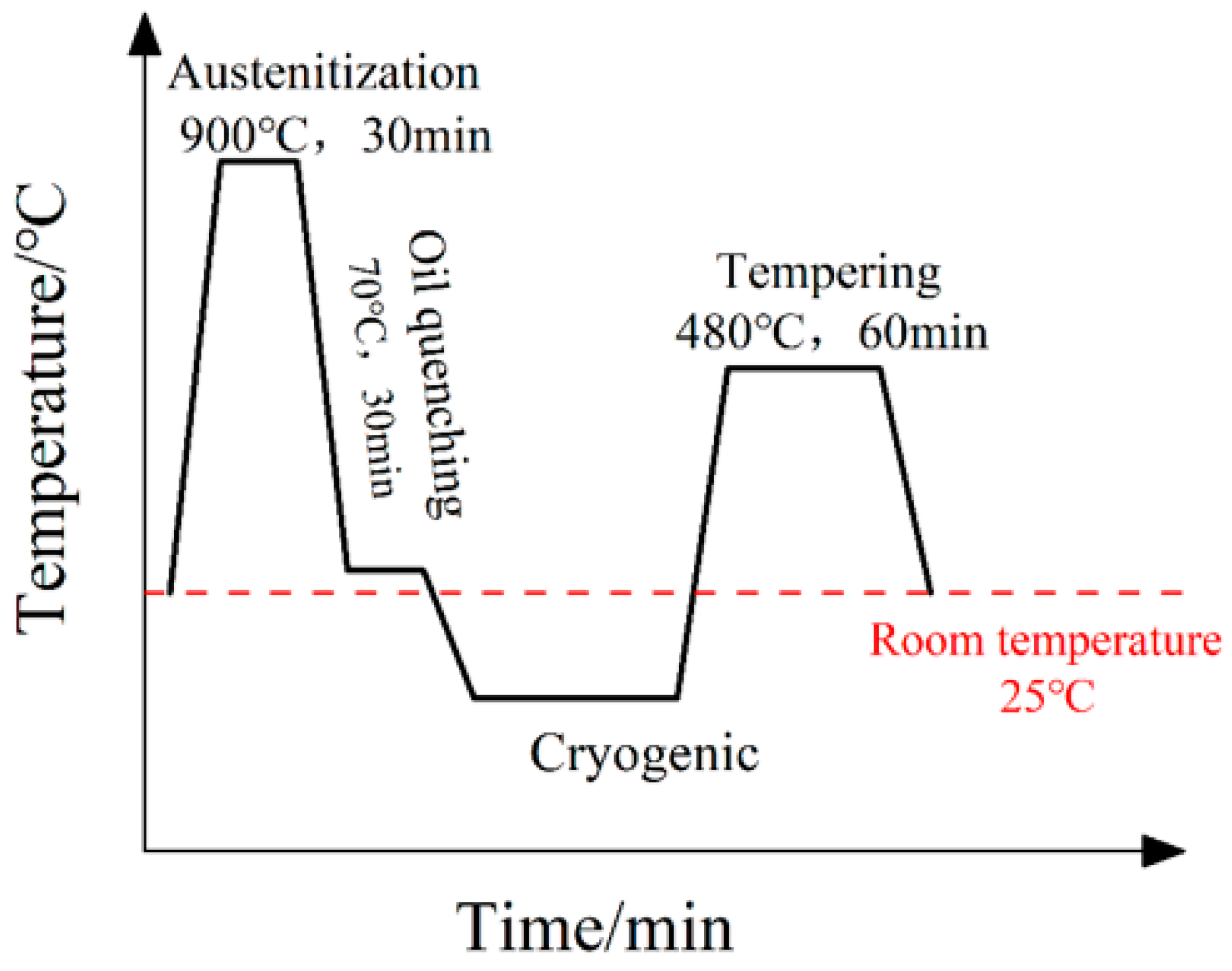


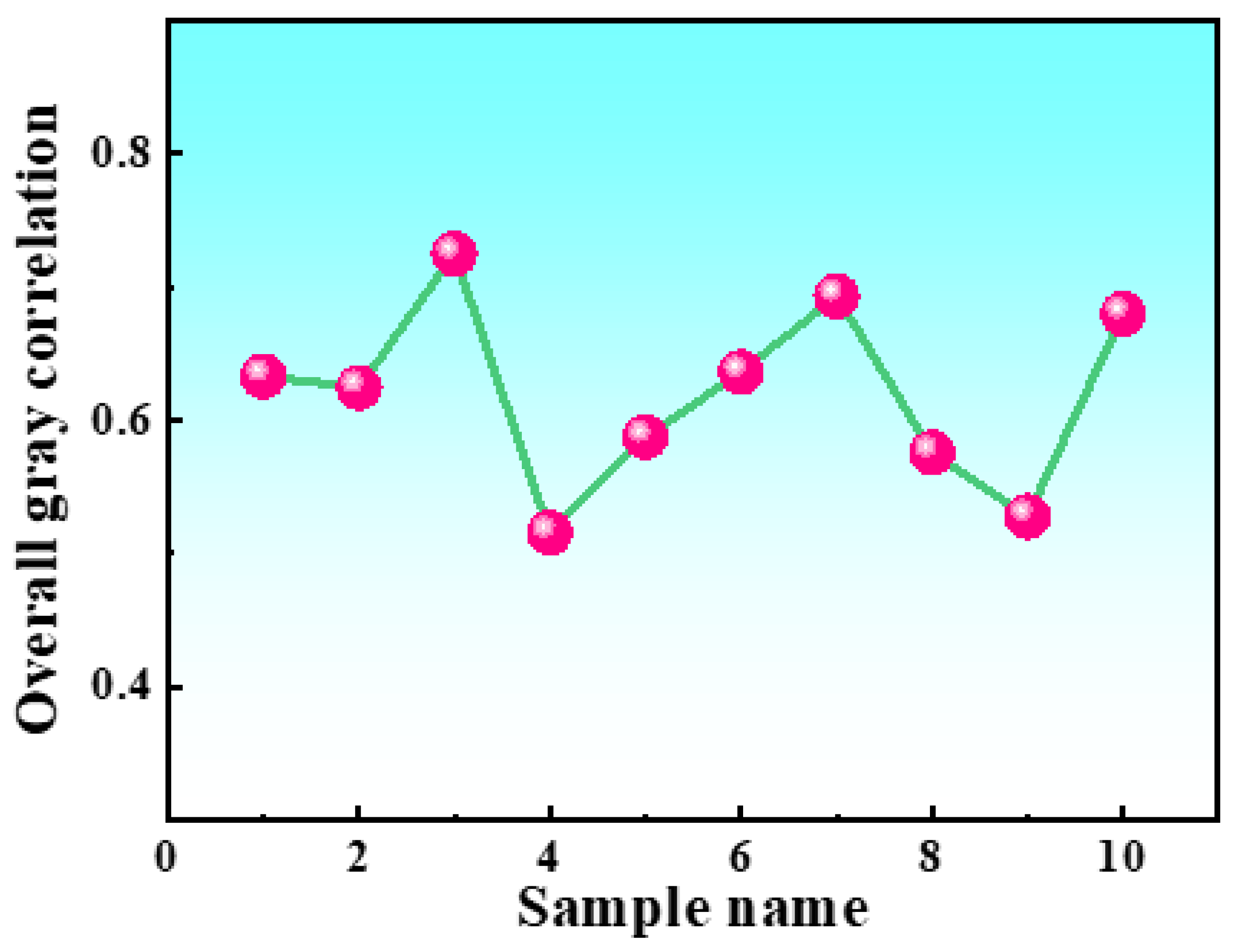
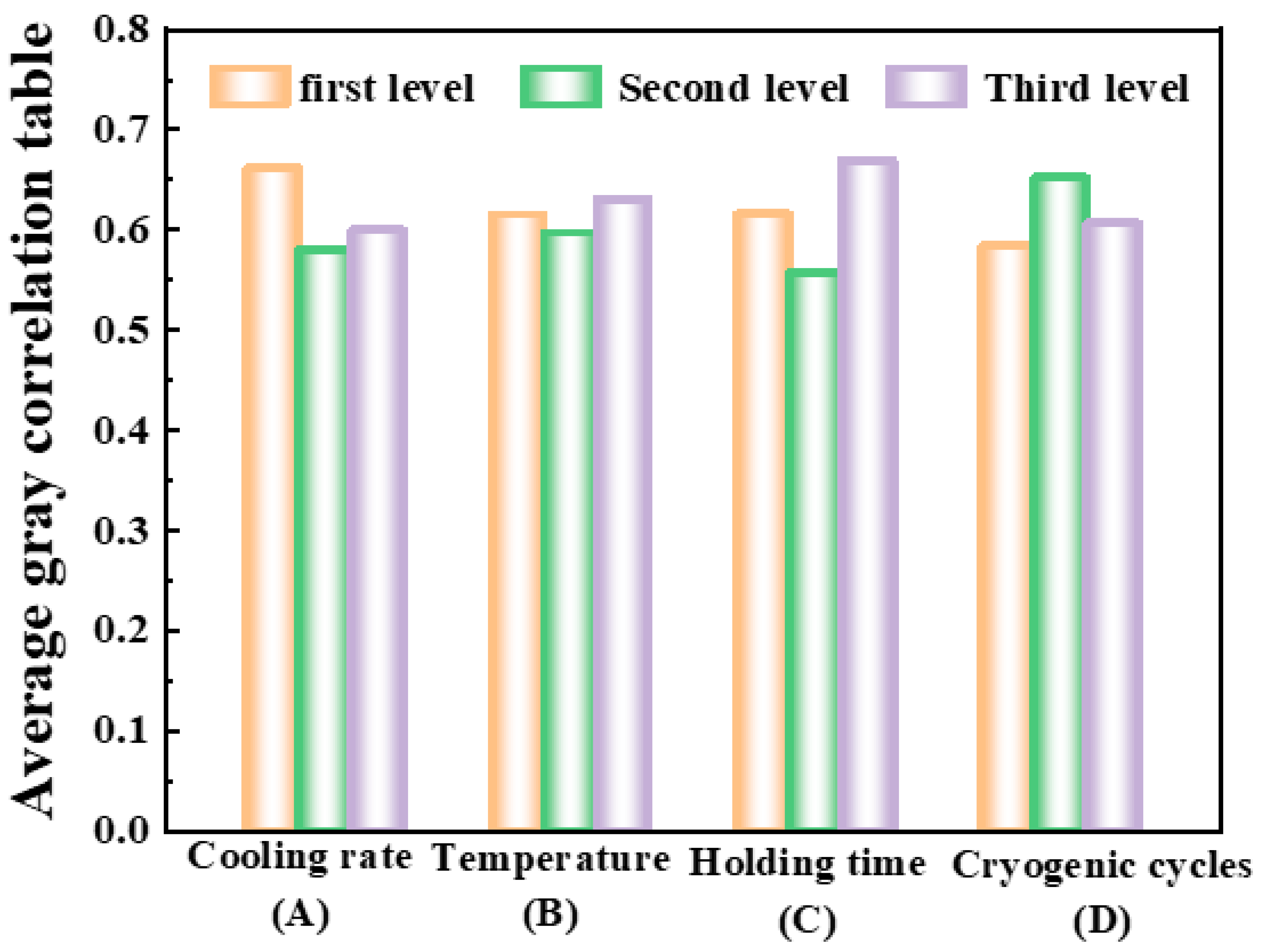

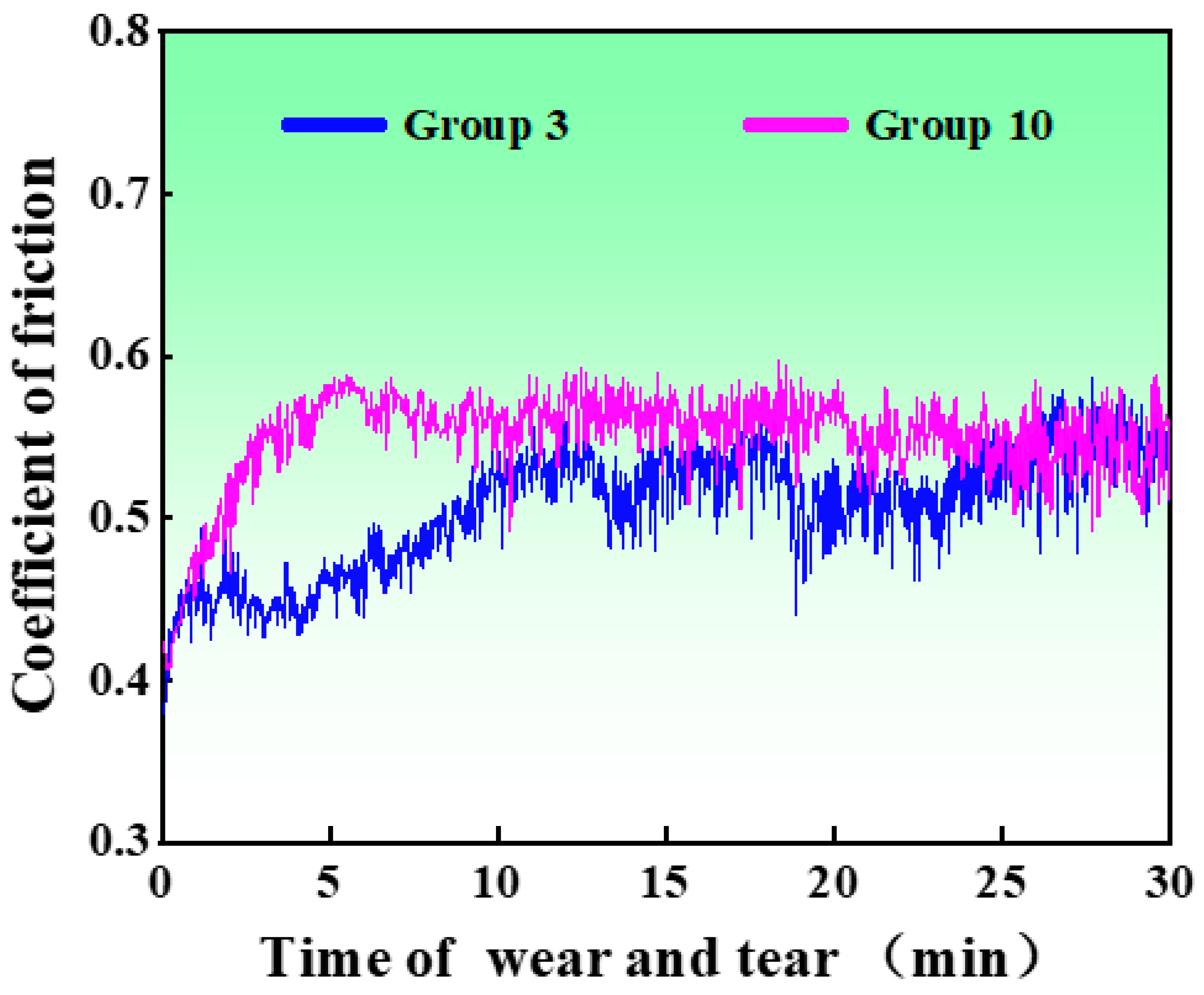

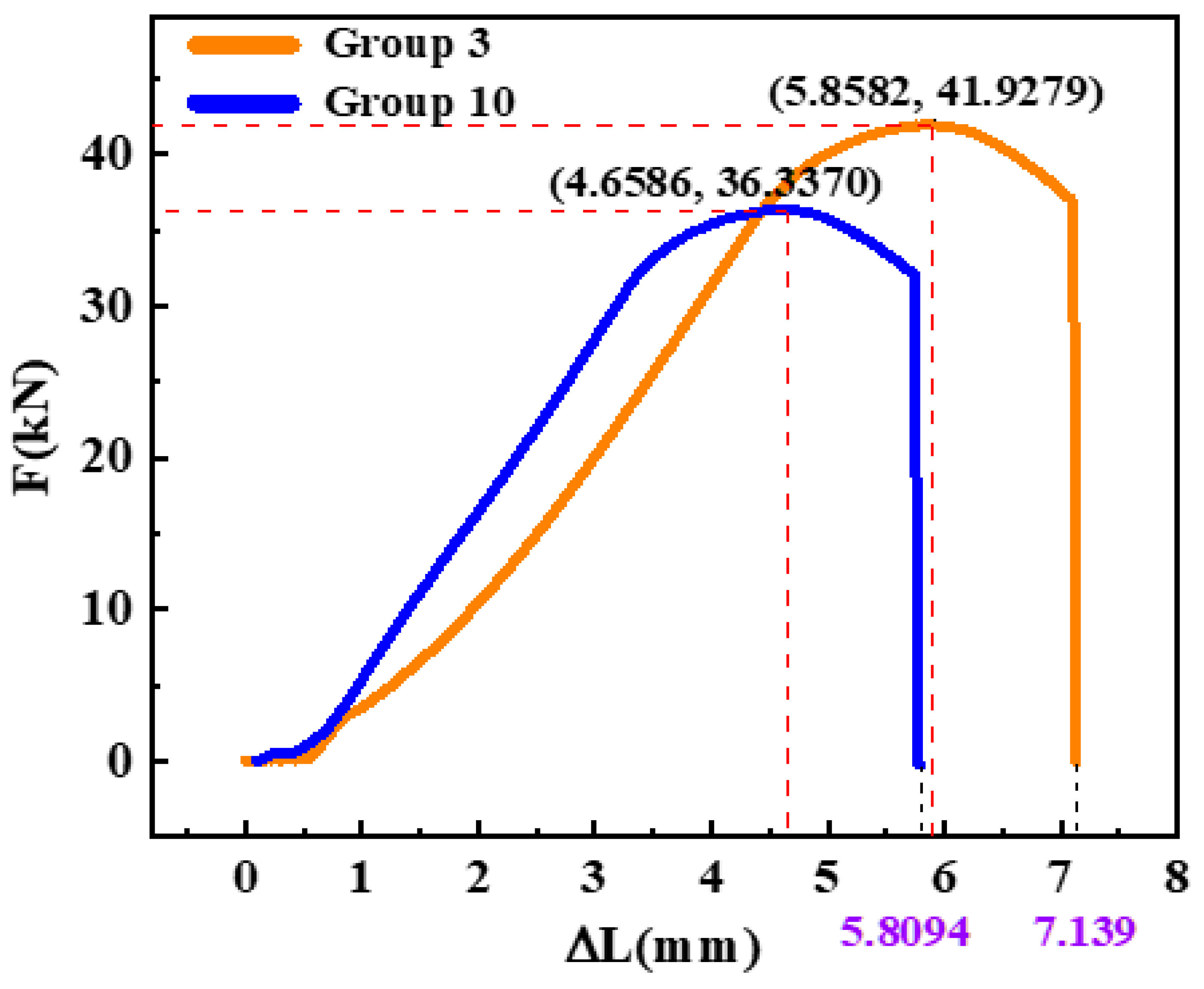
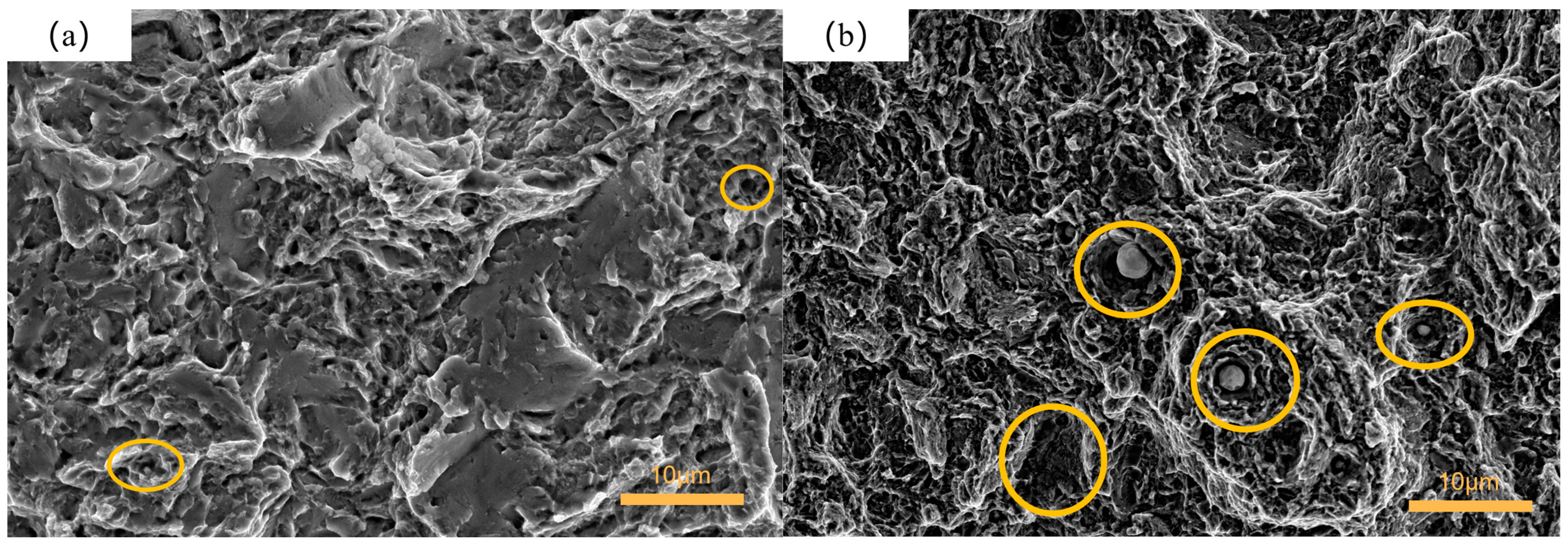


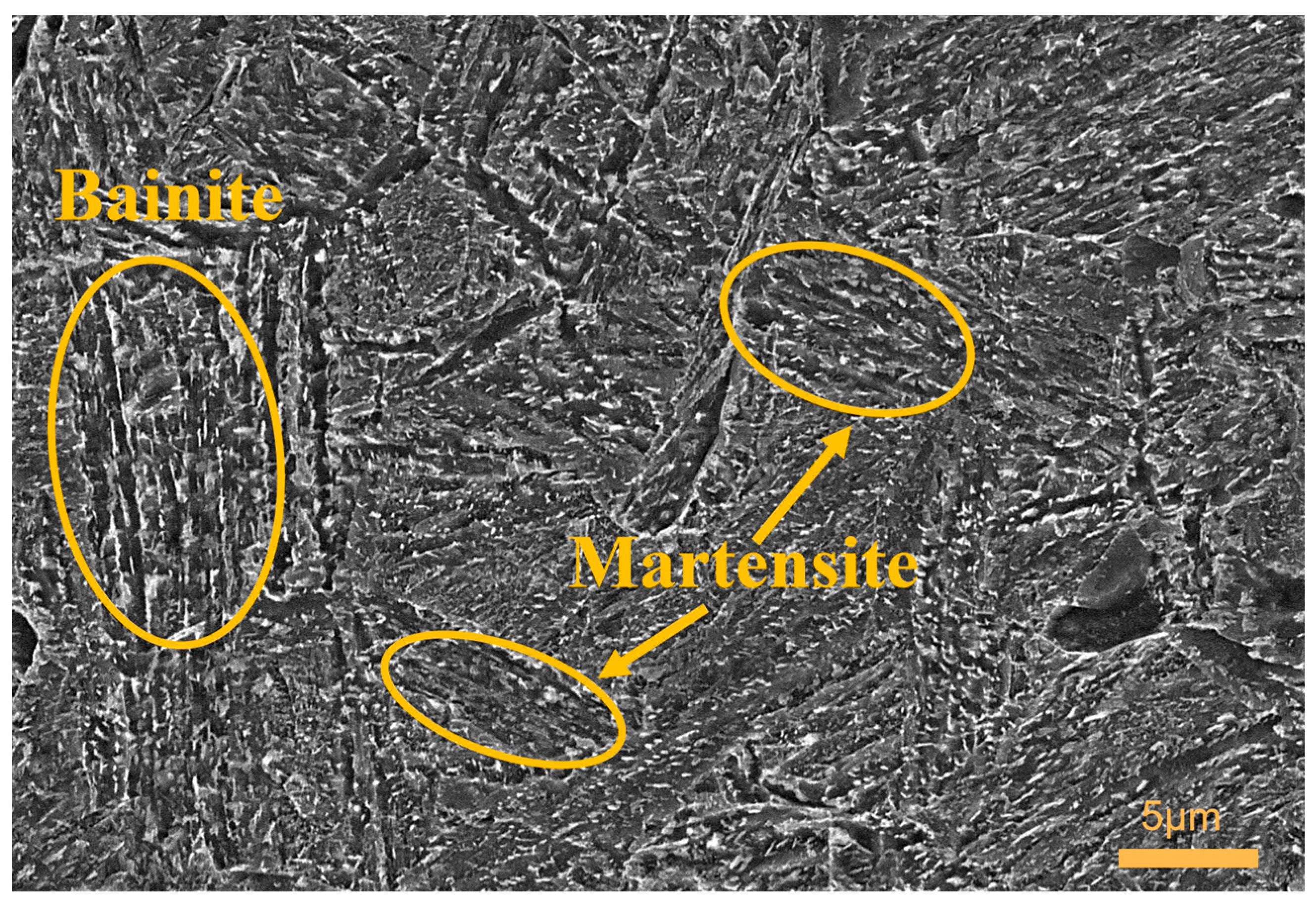
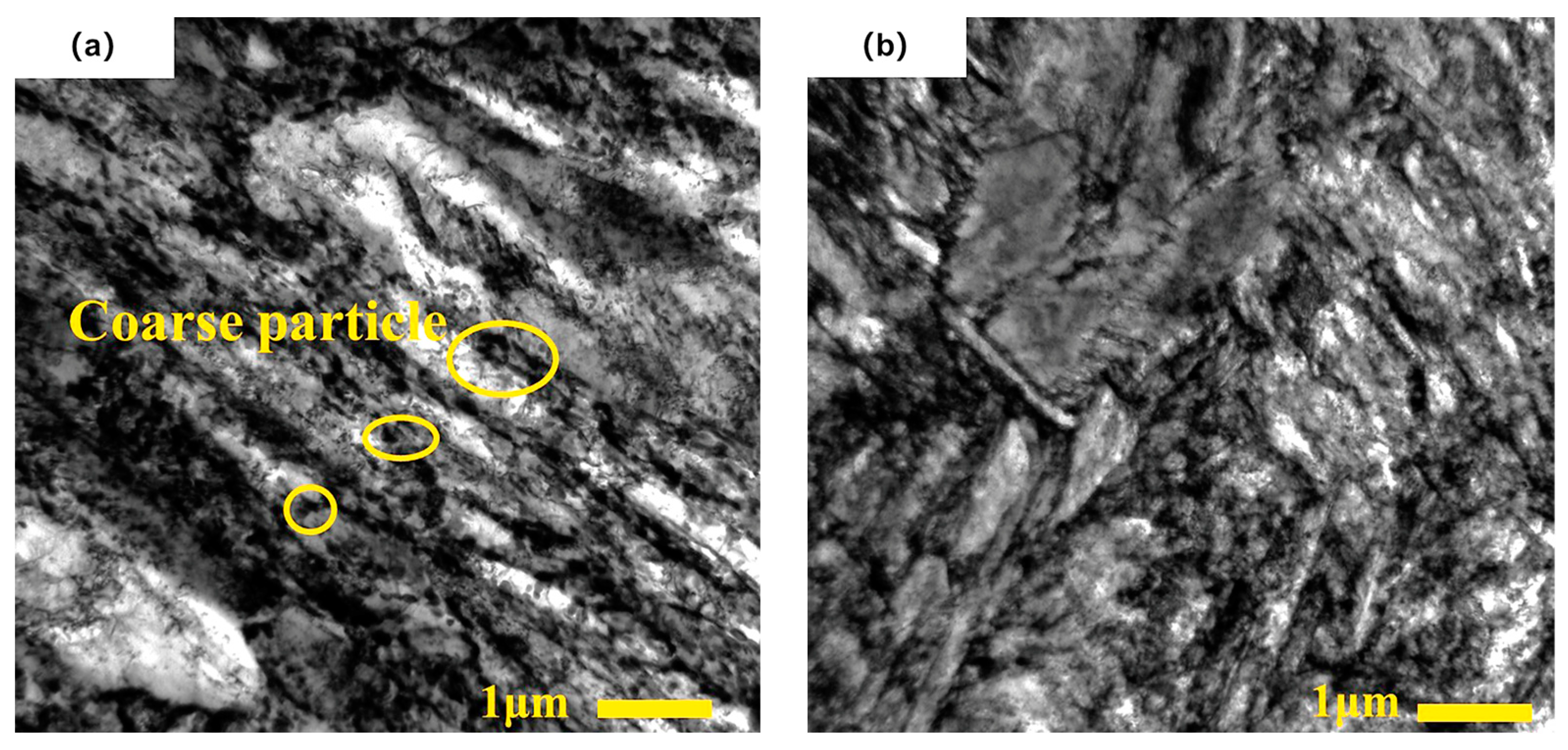
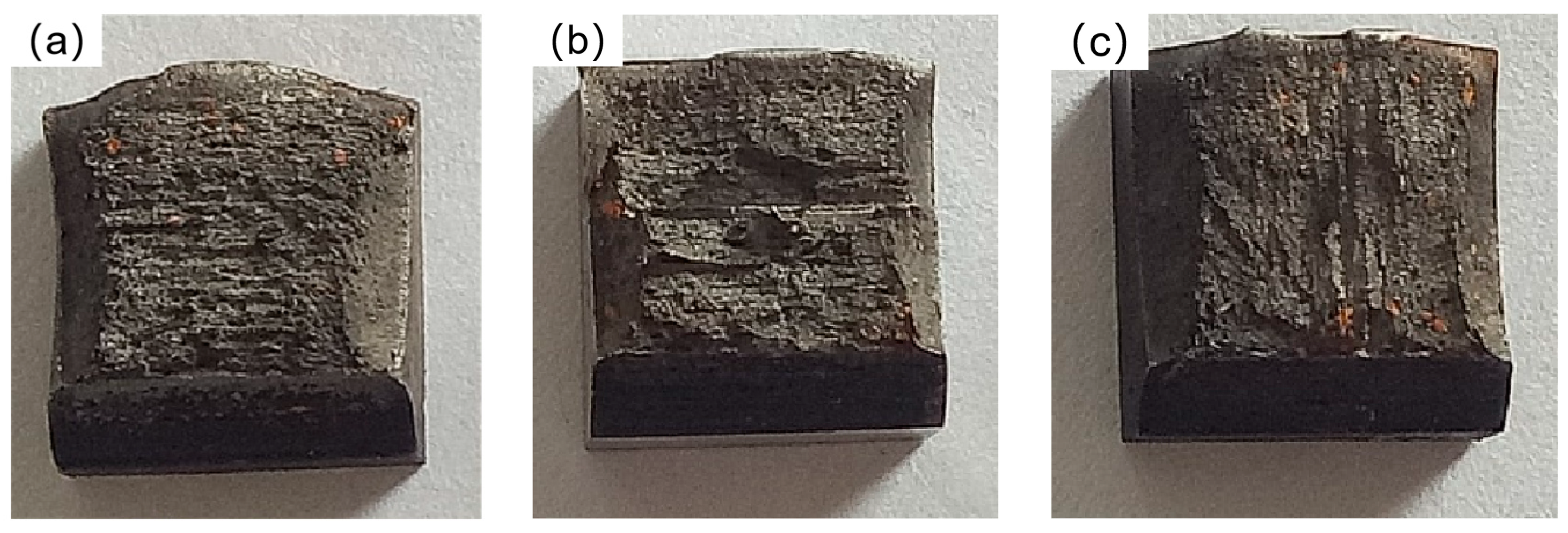



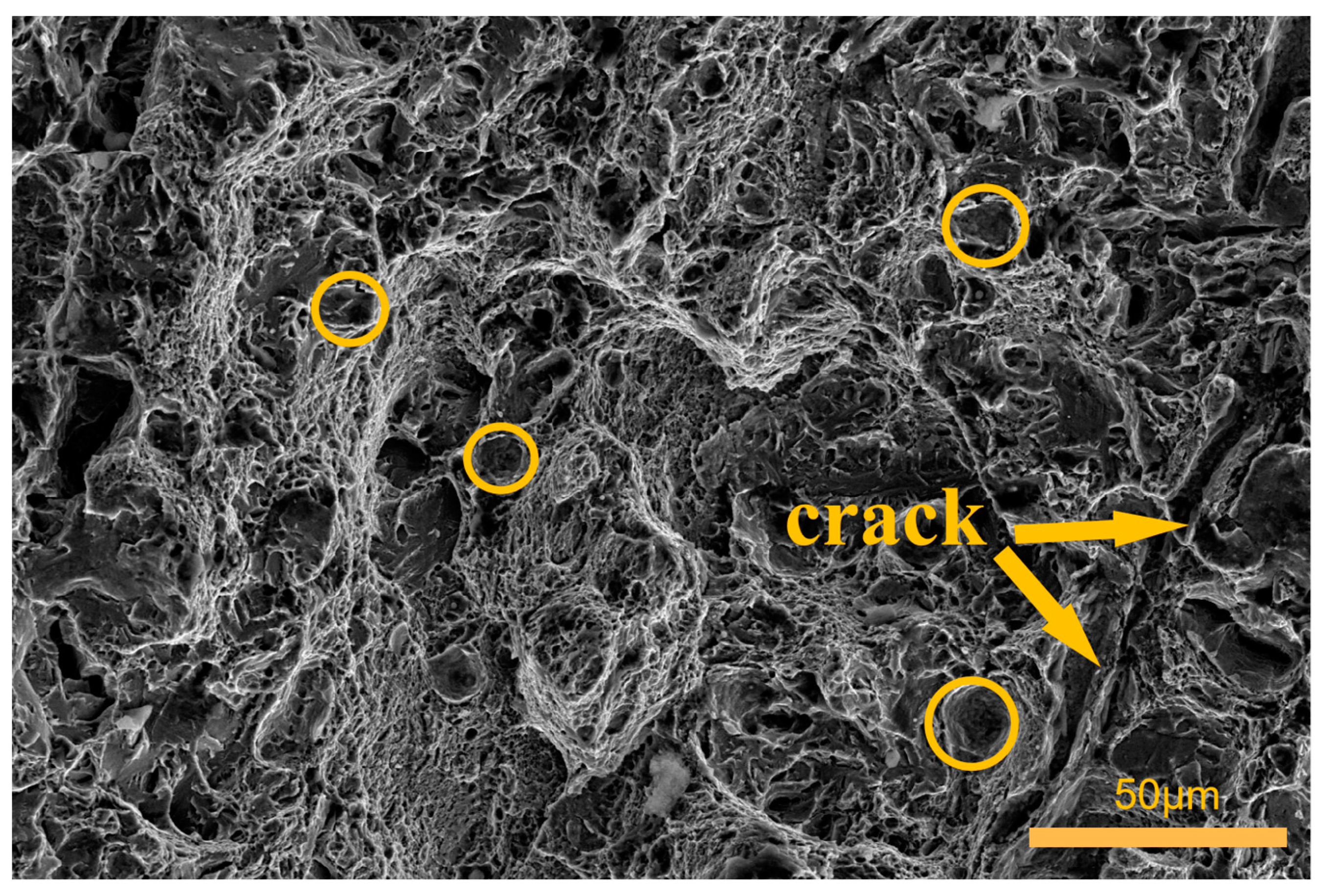
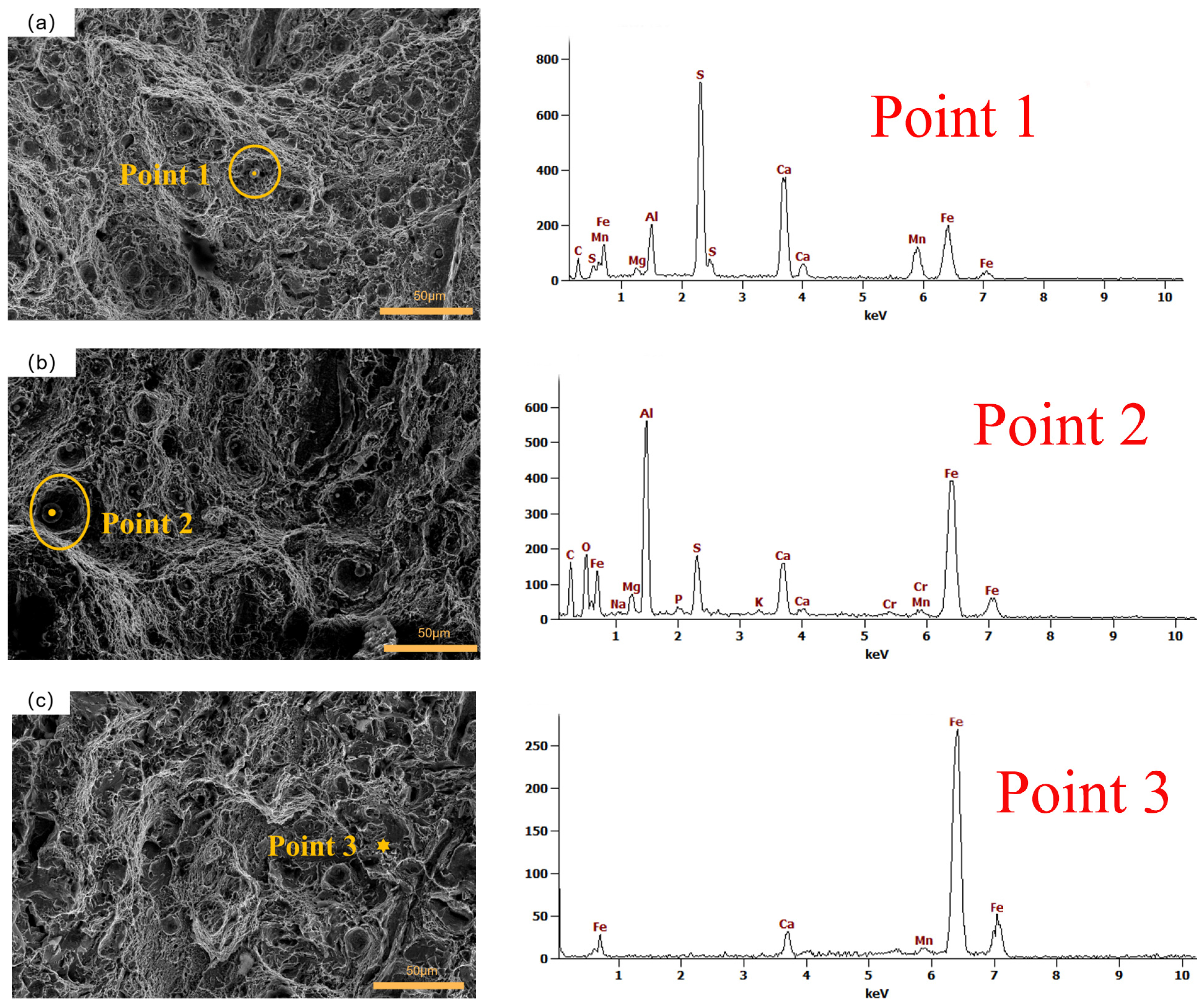
| Element | Mass Percentage | GB/T 1222-2007 |
|---|---|---|
| C | 0.48 | 0.46–0.54 |
| Si | 0.3 | 0.17–0.37 |
| Mn | 0.71 | 0.5–0.8 |
| S | 0.025 | ≤0.025 |
| P | 0.025 | ≤0.025 |
| Cr | 1.02 | 0.8–1.1 |
| Ni | 0.03 | ≤0.035 |
| Cu | 0.02 | ≤0.025 |
| V | 0.12 | 0.1–0.2 |
| Fe | balance |
| Sample Name | Cryogenic Treatment | |||
|---|---|---|---|---|
| Cooling Rate/K·min−1 | Temperature/°C | Holding Time/h | Cryogenic Cycles | |
| 1 | 1 | −120 | 2 | 1 |
| 2 | 1 | −160 | 12 | 2 |
| 3 | 1 | −196 | 24 | 3 |
| 4 | 3 | −120 | 12 | 3 |
| 5 | 3 | −160 | 24 | 1 |
| 6 | 3 | −196 | 2 | 2 |
| 7 | 5 | −120 | 24 | 2 |
| 8 | 5 | −160 | 2 | 3 |
| 9 | 5 | −196 | 12 | 1 |
| 10 | - | - | - | - |
| Load/N | Speed/r·min−1 | Radius/mm | Time/min |
|---|---|---|---|
| 90 | 1500 | 6 | 30 |
| Sample Name | Factors | Performance Metrics | |||||
|---|---|---|---|---|---|---|---|
| Cooling Rate (K/min) | Temperature (°C) | Holding Time (h) | Cryogenic Cycles | Wear Mass Loss (mg) | Hardness (HRC) | Impact Toughness (J/cm2) | |
| 1 | 1 | −120 | 2 | 1 | 4.788 | 38.52 | 36.91 |
| 2 | 1 | −160 | 12 | 2 | 7.933 | 31.97 | 77.01 |
| 3 | 1 | −196 | 24 | 3 | 6.866 | 42.55 | 48.71 |
| 4 | 3 | −120 | 12 | 3 | 51.112 | 33.22 | 87.00 |
| 5 | 3 | −160 | 24 | 1 | 13.308 | 39.38 | 42.89 |
| 6 | 3 | −196 | 2 | 2 | 29.395 | 30.11 | 97.95 |
| 7 | 5 | −120 | 24 | 2 | 17.202 | 43.75 | 41.63 |
| 8 | 5 | −160 | 2 | 3 | 49.522 | 31.33 | 96.23 |
| 9 | 5 | −196 | 12 | 1 | 71.397 | 43.02 | 40.61 |
| 10 | - | - | - | - | 12.113 | 42.51 | 46.83 |
| Level | Wear Mass Loss (mg) | Hardness (HRC) | Impact Toughness (J/cm2) | |||||||||
|---|---|---|---|---|---|---|---|---|---|---|---|---|
| A | B | C | D | A | B | C | D | A | B | C | D | |
| 1 | 19.59 | 73.10 | 83.71 | 89.49 | 113.04 | 115.49 | 99.96 | 120.92 | 162.63 | 165.54 | 231.09 | 120.41 |
| 2 | 93.82 | 70.76 | 130.44 | 54.53 | 102.71 | 102.68 | 108.21 | 105.83 | 227.84 | 216.13 | 204.62 | 216.59 |
| 3 | 138.12 | 107.66 | 37.38 | 107.50 | 118.10 | 115.68 | 125.68 | 107.10 | 178.47 | 187.27 | 133.23 | 231.94 |
| Rx | 118.53 | 36.90 | 93.07 | 52.97 | 15.39 | 13.00 | 25.72 | 15.09 | 65.21 | 50.59 | 97.86 | 111.53 |
| Rank | 1 | 4 | 2 | 3 | 2 | 4 | 1 | 3 | 3 | 4 | 2 | 1 |
| Sample Name | Performance Metrics | ||
|---|---|---|---|
| Wear Mass Loss | Hardness | Impact Toughness | |
| 1 | 1.000000 | 0.61657 | 0.00000 |
| 2 | 0.952784 | 0.13636 | 0.65695 |
| 3 | 0.968803 | 0.91202 | 0.19332 |
| 4 | 0.304538 | 0.22801 | 0.82061 |
| 5 | 0.872089 | 0.67962 | 0.09797 |
| 6 | 0.630575 | 0.00000 | 1.00000 |
| 7 | 0.813629 | 1.00000 | 0.07733 |
| 8 | 0.328409 | 0.08944 | 0.97182 |
| 9 | 0.000000 | 0.94648 | 0.06062 |
| 10 | 0.890030 | 0.90909 | 0.16252 |
| Sample Name | Factors | Gray Relational Coefficient ( ) | Overall Gray Correlation | Rank | |||||
|---|---|---|---|---|---|---|---|---|---|
| A | B | C | D | Wear Mass Loss | Hardness | Impact Toughness | |||
| 1 | 1 | −120 | 2 | 1.00000 | 0.56598 | 0.33333 | 0.63310 | 5 | |
| 2 | 1 | −160 | 12 | 0.91372 | 0.36667 | 0.59308 | 0.62449 | 6 | |
| 3 | 1 | −196 | 24 | 0.94127 | 0.85037 | 0.38265 | 0.72476 | 1 | |
| 4 | 3 | −120 | 12 | 0.41825 | 0.39308 | 0.73595 | 0.51576 | 10 | |
| 5 | 3 | −160 | 24 | 0.79629 | 0.60947 | 0.35663 | 0.58746 | 7 | |
| 6 | 3 | −196 | 2 | 0.57509 | 0.33333 | 1.00000 | 0.63614 | 4 | |
| 7 | 5 | −120 | 24 | 0.72847 | 1.00000 | 0.35145 | 0.69331 | 2 | |
| 8 | 5 | −160 | 2 | 0.42677 | 0.35447 | 0.94665 | 0.57596 | 8 | |
| 9 | 5 | −196 | 12 | 0.33333 | 0.90331 | 0.34737 | 0.52800 | 9 | |
| 10 | - | - | - | 0.81971 | 0.84615 | 0.37384 | 0.67990 | 3 | |
| Level | Factors | |||
|---|---|---|---|---|
| Cooling Rate (A) | Temperature (B) | Holding Time (C) | Cryogenic Cycles (D) | |
| 1 | 0.66078 | 0.61406 | 0.61507 | 0.58286 |
| 2 | 0.57979 | 0.59597 | 0.55609 | 0.65131 |
| 3 | 0.59909 | 0.62964 | 0.66851 | 0.60550 |
| 4 | 0.08100 | 0.03367 | 0.11243 | 0.06846 |
| 5 | 2 | 4 | 1 | 3 |
| Factors | Degrees of Freedom | Sum of Squares | Mean Square Sum | F-Value | Contribution Ratio |
|---|---|---|---|---|---|
| Factor A | 2 | 0.01074 | 0.00537 | 6.30609 | 27.74% |
| Factor C | 2 | 0.01898 | 0.00949 | 11.14222 | 49.01% |
| Factor D | 2 | 0.00730 | 0.00365 | 4.28591 | 18.85% |
| Error | 2 | 0.00170 | 0.00085 | ||
| Total | 8 | 0.03872 |
Disclaimer/Publisher’s Note: The statements, opinions and data contained in all publications are solely those of the individual author(s) and contributor(s) and not of MDPI and/or the editor(s). MDPI and/or the editor(s) disclaim responsibility for any injury to people or property resulting from any ideas, methods, instructions or products referred to in the content. |
© 2023 by the authors. Licensee MDPI, Basel, Switzerland. This article is an open access article distributed under the terms and conditions of the Creative Commons Attribution (CC BY) license (https://creativecommons.org/licenses/by/4.0/).
Share and Cite
Chen, Z.; Jing, L.; Gao, Y.; Huang, Y.; Guo, J.; Yan, X. Impact of Cryogenic Treatment Process on the Performance of 51CrV4 Steel. Materials 2023, 16, 4399. https://doi.org/10.3390/ma16124399
Chen Z, Jing L, Gao Y, Huang Y, Guo J, Yan X. Impact of Cryogenic Treatment Process on the Performance of 51CrV4 Steel. Materials. 2023; 16(12):4399. https://doi.org/10.3390/ma16124399
Chicago/Turabian StyleChen, Zhi, Linwang Jing, Yuan Gao, Yao Huang, Jia Guo, and Xianguo Yan. 2023. "Impact of Cryogenic Treatment Process on the Performance of 51CrV4 Steel" Materials 16, no. 12: 4399. https://doi.org/10.3390/ma16124399




